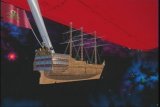

Quick Links:
Queen Emeraldas
Young Hiroshi has the misfortune of stowing away on a freighter targeted by raiders of the Alfressian Empire. By chance, however, the lead Alfressian raiding ship has made a fatal mistake: displaying the skull and crossbones on crimson. Only two people in this universe have earned the right to display this emblem, and Emeraldas materializes shortly to “explain” this while incidentally saving the raiders’ victims….
The plot for Queen Emeraldas revolves around the character growth of the young boy Hiroshi, in spite of its title. Queen Emeraldas merely serves as a convenient role model and catalyst for the plot. There are scenes which give some insight into the impressive character of Emeraldas, but at the same time it is disappointing to see her facing down the entire Alfressian fleet in the second episode using sheer brute force instead of some form of ingenuity. After seeing her use the Queen Emeraldas in some intriguing ways in the first episode, this second major battle becomes fairly anticlimactic in some sense. In terms of the premise, the propensity for the Alfressians to raid and the close proximity of their rather overwhelming fleet is not fully explained, relying on background provided by Matsumoto’s earlier works, such as Star Blazers and Captain Harlock. Such references do not inhibit the overall enjoyment of the film, though at the end there is an unnecessary amount of name-dropping. As a whole the plot is functional but more as an introduction to the story of Hiroshi than as a tribute to Emeraldas’s daring, in spite of her highlights in the anime. When forced to stand alone, however, the given plot just doesn't offer that much because it is just an introduction, and a mediocre one at that.
The characters in Queen Emeraldas are for the most part well-conceived. Emeraldas is a rather striking character, who shows both ingenuity in the first episode and incredible prowess in the second, though to a somewhat absurd degree. Hiroshi is a young, abandoned kid who grows out of his self-imposed isolation over the course of the anime, developing in spite of his own intentions in response to the role models and guidance he receives. The character designs are quite distinctive for the most part, if not attractive, though many of Matsumoto’s females look alike aside from their hair color. Some of the aspects of the inventor Tochiro which manifest from time to time in Hiroshi’s animation are also well-done, though their full efficacy can only be realized if the series is continued. The villains, however, are for the most part too simplified, especially given that their omnipresence is not fully addressed in this series.
Animation is a mixed bag, with a wide range of animation techniques used. For the most part the animation relies on camera tricks performed on very well-detailed stills, yet during the space battles the animation quality steps up from time to time. The duel involving Emeraldas similarly has mixed animation style, beginning with some fairly fluid fencing, then regressing to the kind of battle where two posed bodies move towards each other against a background of zigzags which in theory represents the heightened emotional tension of the duel. The kind of animation presented in the space battles most closely represents the kind of mass destruction in Gundam Wing with masses of fleets firing back and forth in a more detailed version of the Legend of Galactic Heroes fleet combat. As a whole, though, the impact of the battle animation is nowhere near intense as in either Macross Plus or Gundam: Char’s Counterattack, in spite of ADV’s hype. The CG animation in particular rarely blends in well with the cel animation and tends to stand out like a sore thumb.
The soundtrack for Queen Emeraldas works fairly effectively. The theme songs grow on you, and the orchestral classical accompaniment is on target in its use. There are some acoustical attempts to capture that space frontier feel, but there is still nothing quite as moody as in either Outlaw Star or Cowboy Bebop.
As it stands now, Queen Emeraldas is at best a promising introduction. It might stand on its own as a tribute for fans of Matsumoto’s manga or other anime series, but the variety of themes addressed demand a continuation of Hiroshi and Emeraldas’s saga. It is enjoyable to watch primarily if you can accept that it as a prelude and not a complete, self-contained tribute to Emeraldas. The ending reminded me a lot of the kind of loose ends in Heroic Legend of Arislan, though at least in this case the audience has a minor chance at the series being continued, since two more OVAs were released in Japan. The problem is that ADV has not demonstrated any interest in translating this second pair of episodes for two years now, yet because they have the translation rights, no honest fansubber is going to start work on this missing link. Because of this, I would strongly advise newcomers to the “Leijiverse” to steer clear of Queen Emeraldas. Without more background and more story, there’s just not enough here to makes the viewing worthwhile.
As a technical aside, the DVD release is also nothing to write home about. Aside from the inconsistent video quality of the transfer, the Japanese and French audio tracks actually get swapped for part of the second episode...and then swap back part way into the episode! This is a disc defect which ADV has never corrected, and has no plans to correct, so let the buyer beware. The "extras" amount to a brief character description for Hiroshi and Queen Emeraldas, followed by a screenshot gallery. Return to the fact that this is a two episode DVD, and it becomes eminently clear how poor a deal the DVD afficianado is in for with this disc.
Distributor: ADV Creator: Kodansha Released: 1998
Plot: C+ Character Design: B+ Animation Quality: B Music: B+ Overall: C+



